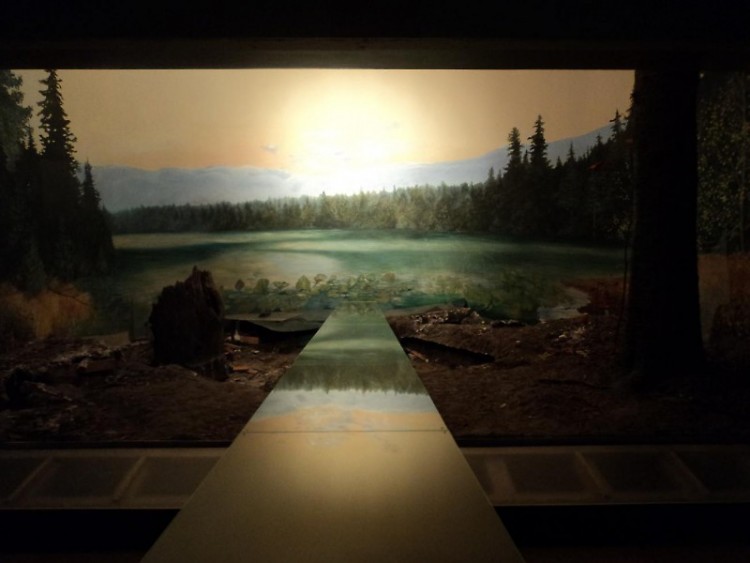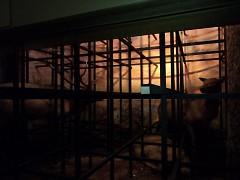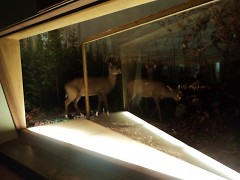New York-based artist Alois Kronschlaeger returns for his second year participating in ArtPrize with his new installation, Habitat. Using the space in the old Grand Rapids Public Museum building, Kronschlaeger put the museum’s abandoned taxidermied animals and their habitats to use.
"The rule was don't touch the animals," Kronschlaeger explains. He goes on to say he was told to "treat [the space] like an artifiact [and] work at a certain coexistence."
The idea materialized as a result of last year's ArtPrize, when Kronschlaeger used the old Public Museum as storage for his scale model of Spire. As a sort of experiment he placed it inside one of the habitats to see how it would look, and soon after began developing ideas for an istallation piece. Habitat's formative process involved looking over the original blueprints of the space, taking measurements and negotiating his access to the habitats and their remaining inhabitants, followed by performing three weeks of intensive construction within the space.
The habitats’ original construction harkens back to 1940 when the museum first opened. Through a combination of the natural and the modern, Kronschlaeger has created a juxtaposition of contemporary architecture that largely manages to complement the natural habitats and their recycled inhabitants. The result is an ambiguous but striking combination of natural and artificial resources and construction.
"This is a very awkward imagery of juxtaposition," he says. Cohesion between the different components wasn't the overarching goal of the piece. He says he spent a lot of time wondering how to "bring something to the diorama that creates a sort of double narrative but is overlaid by geometric abstraction." He wanted his additions to the habitats to feel like a disruption of the space.
Several viewers expressed both confusion and intrigue while walking through Habitat.
“I’m trying to figure it out,” says viewer Lynn Black as she wanders through the exhibit. “It’s hard to know what’s old and what’s new.”
“I’m having a hard time knowing what to look at,” agrees Marissa Black.
Because the architecture is integrated into and throughout the habitats it affects the various dioramas differently. Two are joined by a very geometric bridge, which creates its own combination of connection and contrast while the theme for some of the other dioramas is the addition of new dimension within the individual space. While some of the structures are rigid and very obviously modern, others are more fluid and provide an additional organic element to some of the spaces.
“I like the adapted re-use,” viewer Todd Emeotte says of the exhibit as a whole. More than Kronschlaeger’s individual use of recycled materials, the use of the building itself for SiTE:LAB implements recycling and readaptation on a much larger scale.
When asked about ArtPrize as a whole, the viewers’ responses were entirely positive.
“It’s awesome,” Marrisa Black says. “I get excited every year.”
“I like the evolution of the event,” Todd Emeotte notes.
“It’s a nice excuse to get downtown,” adds Emeotte’s companion, Rob McDougal.
“It’s fun, exciting and free,” grins Lynn Black.
"I think ArtPrize is great for Grand Rapids," Kronschlaeger agrees. "Me, as an artist, I do it because of the space. This year is the same thing. I trust Paul Amenta is putting an amazing show together, that it's a great venue and that it's not buying into the public thing. I respect ArtPrize and it's a lot of work."
Habitat is joined by over a dozen other installations at SiTE:LAB at 54 Jefferson SE. Each implements the old museum’s space in unique and intriguing ways, bringing new life and dimension to a long-dormant space.
The Rapidian, a program of the 501(c)3 nonprofit Community Media Center, relies on the community’s support to help cover the cost of training reporters and publishing content.
We need your help.
If each of our readers and content creators who values this community platform help support its creation and maintenance, The Rapidian can continue to educate and facilitate a conversation around issues for years to come.
Please support The Rapidian and make a contribution today.


